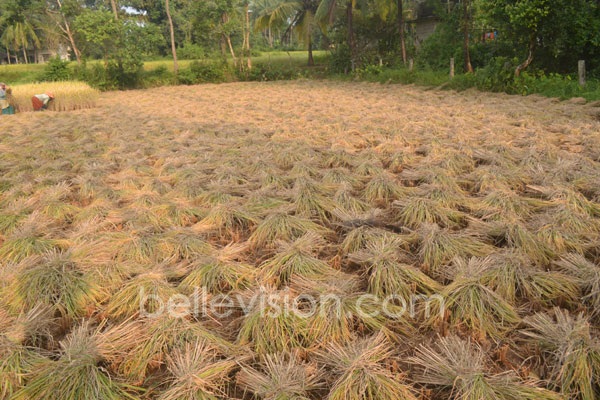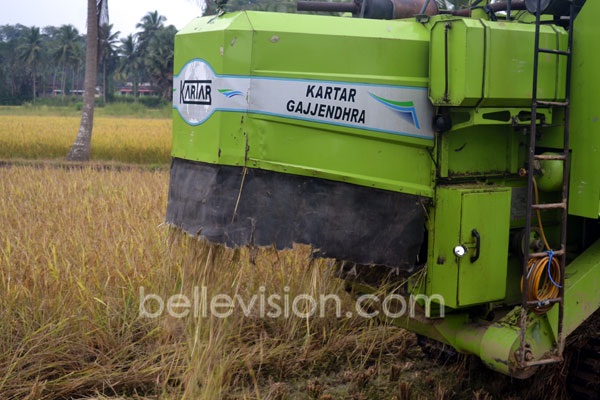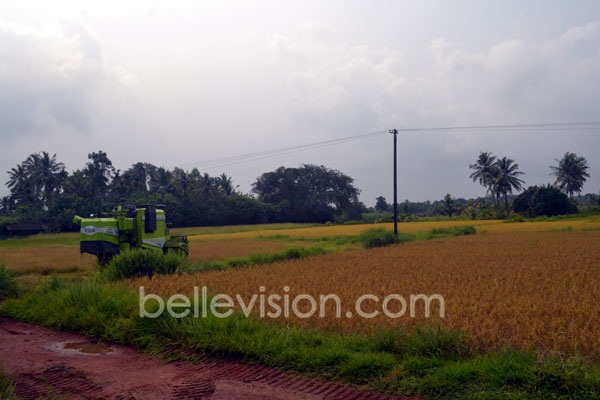

Udupi/M’Belle: In the face of labour shortage Paddy Harvester comes to the rescue of farmers
By Eugene DSouza
Bellevision Media Network
Udupi, 10 Oct 2014: This year, though initially there was delay in the onset of the monsoon, there was continuous rainfall which helped the farmers to cultivate their farms. In spite of intermittent heavy rains there were no major floods and the paddy crop has been quite good.
The crop is ready for harvesting and the fields with the ripening paddy wear a golden look. An evening walk by the side of these fields with gently blowing breeze and colourful view soothes the tired senses and transports one to the land of tranquility and peace. However, the farmers cannot enjoy such sentiments as they are the most worried lot as they desperately seek ways and means to get the ripened paddy harvested.
Though agriculture has been gradually declining due to multifarious reasons, those who still possess cultivable land and believe in continuing the tradition of growing at least one crop find it extremely difficult to carry on the exercise due to non availability of seasonal agricultural labourers. The local labourers being few in number they are much in demand during the prime agricultural activities such as transplanting of saplings and harvesting.
The farmers somehow manage to get their agricultural land ploughed through the mechanical tillers and transplant the saplings as some delay may not cause much damage. However, it is during the harvesting season that the farmers have greater anxiety. In the first place there is the fear of rains which may damage the crop and in the second place the non-availability of labourers which may cause delay in harvesting and paddy grains may get over ripened and fall off in the field. As such, once the paddy reaches the optimum ripening stage, the farmer has to make arrangements to get the paddy harvested and stored.
Since few years, the non availability of agricultural labourers at the right time for harvesting has prompted the farmers to depend on the harvesting machine which can harvest vast areas within hours. When these harvesting machines were introduced in the coastal region, it became a novelty and many people would muster to see how the machine operated. In most of the cases, these harvesting machines have been brought from outside the twin districts.























When this reporter met Edward Alva and Ashok Shetty who own farming lands side by side in Batta Sal in Padubelle and inquired about the harvesting of their crop, they lamented over the scarcity of labourers. And even when they are available the output of their labour compared to the wages, breakfast, lunch and tea has been quite unsatisfactory. Edward Alva said that he has requisitioned the service of the harvester which would be available the next day.
Having received the information about the arrival of the harvester, this reporter went to see personally the harvesting operation. Within half an hour the entire field was harvested. While the hay was left in the field, the grain was stored in the machine which was later emptied on the spread out sheets of tarpaulin from where it was carried in sacks to the house of Edward Alva.
To know more about the business of harvester, this reporter spoke to Venkat, the manager of the team of operators. The harvester belongs to S. Pravin one of his relatives in Bellary who owns five such harvesters. Presently, two of his harvesters are operating in Udupi. Each harvester costs around 23 lakhs of rupees. These harvesters are manufactured by Kartar Agro Industries Private Limited in Patiala, Punjab. This Hurricane Harvester is known as ‘Gajjendhra’ Model 3500 (G). To transport each of these harvesters to the farmland, truck-like vehicles known as canters costing around 12 lakhs of rupees are to be used. The team of operators for each harvester comprises of one manager, two harvester operators, usually from Haryana and a cleaner.
When asked about the charges for harvesting certain area of land, Venkat said that the farmers are charged not on the basis of the area of their land but on hourly basis. For each hour of operation, the charges are Rs.2,200/- In spite of the seemingly high charges, both farmers and operators feel that getting the crop harvested by the harvesting machine is much more economical than the human labour. In fact the cost of harvesting a particular piece of farmland through the harvester is half of the expenditure involved in getting the same piece of land harvested by hired labour. Besides, it saves a lot of time, energy and anxiety.
After completing the harvesting operations on demand in Udupi district, Venkat and his team would move to other regions wherever there is demand. According to Venkat, their harvesting machines are being sought by farmers in other states such as Andhra Pradesh, Orissa and even Uttar Pradesh.
The agricultural scene in the coastal region, especially in Udupi and Mangalore districts has undergone a sea change. Many traditional farmers have either fully given up cultivating their farmland or have reduced the area of cultivation due to various reasons. Joint families have given way to nuclear families, thus reducing the manpower in traditional agricultural families. Educational opportunities and mobility have provided alternate employment opportunities by which people are no longer required to depend on agriculture either for labour or for sustenance. Bullocks or buffaloes, once the pride of the farmers and identity of the villages have practically disappeared and their place has been taken by the machine tillers.
The farmers have been forced to adapt themselves to changing times and circumstances. Hence, during the time of harvest when they are unable to get enough labourers at the right time, harvesting machines have come to the rescue of these farmers.